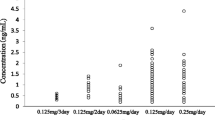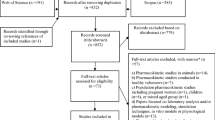Abstract
Objective
To evaluate digoxin pharmacokinetic parameters using Bayesian estimation in 60 patients, and to identify factors that appeared to affect the risk of digoxin toxicity.
Patients and Methods
60 patients with serum digoxin concentrations were evaluated retrospectively. We collected demographic, clinical and laboratory data, and information on concurrent medications and clinical and electrocardiographic features of digoxin toxicity. The incidence of digoxin toxicity was evaluated in 50 patients. Serum digoxin concentrations were measured with fluorescence polarisation immunoassay Individual pharmacokinetic parameters were estimated by Bayesian method using Abbottbase Pharmacokinetic Systems.
Results
Signs of digoxin toxicity were present in 23 patients (46%). Patients without signs of digoxin toxicity had a significantly lower mean serum digoxin concentration than patients with signs, 1.99 ± 0.9 μg/L vs 2.7 ± 1.5 μ.g/L, respectively (p = 0.047). Patients with serum digoxin concentrations >2.2 μg/L differed significantly from those with values ≤2.2 μg/L, respectively, for the following parameters: age (82.0 ± 8.0 vs 72.0 ± 16.0 years; p = 0.005), serum creatinine levels (133.0 ± 55.0 vs 106.0 ± 26.0 μmo1/L; p = 0.012), bodyweight (57.4 ± 12.8 vs 69.2 ± 17.8kg; p = 0.01), volume of distribution (208.5 ± 89.5 vs 315.7 ± 91.2L; p = 0.0001), total clearance (1.60 ± 0.65 vs 3.4 ± 1.5 L/h; p = 0.0001), and elimination half-life (94.2 ± 28.6 vs 72.4 ± 16.7h; p = 0.001). Estimation of optimal dose showed that the doses recommended in intoxicated patients should be 3.5 times lower to reach the therapeutic range.
Conclusion
Digoxin concentrations were higher in patients with toxicity. Older age enhanced the risk of digoxin toxicity. Monitoring digoxin concentrations may help to confirm suspected digitalis toxicity.






Similar content being viewed by others
Reference
Duhme DW, Greenblatt DJ, Koch-Weser J. Reduction of digoxin toxicity associated with measurement of serum levels: a report from the Boston Collaborative drug surveillance program. Ann Intern Med 1974; 80: 516–19
Measurement of serum levels: a report from the Boston Collaborative drug surveillance
Duhme DW, Greenblatt DJ, Koch-Weser J. Reduction of digoxin toxicity associated with measurement of serum levels. A report from the Boston Collaborative Drug Surveillance Program. Ann Intern Med 1974; 80: 516–19
Jelliffe R. Goal-oriented, model-based drug regimens: setting individualized goals for each patient. Ther Drug Monit 2000; 22: 325–9
Smith TW, Haber E. Digoxin intoxication: the relationship of clinical presentation to serum digoxin concentration. J Clin Invest 1970; 49: 2377–86
Aronson JK, Grahame-Smith DG, Wigley FM. Monitoring digoxin therapy. The use of plasma digoxin concentration measurements in the diagnosis of digoxin toxicity. Q J Med 1978; 186: 111–2
Cockroft DW, Gault MH. Prediction of creatinine clearance from serum creatinine. Nephron 1976; 16: 31–41
Sheiner LB, Beal SL, Rosenberg B. Forecasting individual pharmacokinetics. Clin Pharmacol Ther 1979; 31: 294–305
Sheiner LB, Rosenberg B, Melmon KL. Modelling individual pharmacokinetics for computer-aided drug dosage. Comput Biomed Res 1972; 5: 441–59
Sheiner LB, Beal SL. Bayesian individualization of pharmacokinetics: simple implementation and comparison with non-Bayesian methods. J Pharm sci 1982; 71: 1344–48
Sheiner LB, Rosenberg B, Marathe VV. Estimation of population characteristics of pharmacokinetic parameters from routine clinical data. J Pharmacokinet Biopharm 1977; 5: 445–79
Marcus FI. Pharmacokinetic interaction between digoxin and other drugs. J Am Coll Cardiol 1985; 5Suppl. A: 82A–90A
Sheiner LB, Beal SL. Some suggestions for measuring predictive performance. J Pharmacokinet Biopharm 1981; 9: 503–12
Kelly RA, Smith TW. Use and misuse of digitalis blood levels. Heart Dis Stroke 1992; 1: 117–22
Lewis RP. Cardiotonic drugs: a clinical survey. In: Leier CV, editor. Digitalis, New York: Marcel Dekker Inc, 1987: 58–150
Kelly RA, Smith TW. Digoxin in heart failure: implications of recent trials. J Am Coll Cardiol 1993; 22: 107A–2A
Haji SA, Movahed A. Update on digoxin therapy in congestive heart failure. Am Fam Physician 2000; 15: 409–16
Kelly RA, Smith TW. Pharmacological treatment of heart failure. In: Goodman and Gilman. The pharmacological basis of therapeutics. 9th ed. 1995: 814–20
Kelly RA, Smith TW. Recognition and management of digitalis toxicity. Am J Cardiol 1992; 69: 108–9
Belier GA, Smith TW, Abelmann WH, et al. Digitalis intoxication: a prospective clinical study with serum level correlations. N Engl J Med 1971; 284: 989–97
Lely AH, Van Enter CH. Noncardiac symptoms of digitalis intoxication. Am Heart J 1972; 83: 149–52
Lee TH, Smith TW. Serum digoxin concentration and diagnosis of digitalis toxicity. Clin Pharmacokinet 1983; 8: 279–85
Park GD, Spector R, Goldberg MJ. Digoxin toxicity in patients with high serum digoxin concentrations. Am J Med sci 1987; 294: 423–8
Shapiro W. Correlative studies of serum digitalis levels and the arrhythmias of digitalis intoxication. Am J Cardiol 1978; 41: 852–9
Williamson KM, Thrasher KA, Fulton KB, et al. Digoxin toxicity: an evaluation in current clinical practice. Arch Intern Med 1998; 158: 2444–9
Pierges AA, Worwag EM, Atkinson AJ. A concurrent audit of high dose digoxin plasma levels. Clin Pharmacol Ther 1994; 55: 353–8
Author information
Authors and Affiliations
Corresponding author
Rights and permissions
About this article
Cite this article
Lecointre, K., Pisanté, L., Fauvelle, F. et al. Digoxin Toxicity. Clin. Drug Investig. 21, 225–232 (2001). https://doi.org/10.2165/00044011-200121030-00009
Published:
Issue Date:
DOI: https://doi.org/10.2165/00044011-200121030-00009




